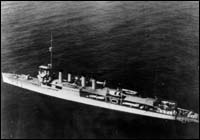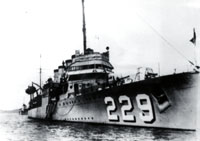Truxtun Crew
USS Truxtun (DD-229) was a four-stack destroyer in the United States Navy. It was commissioned on February, 16 1921 and served for a year along the Atlantic seaboard and in the Caribbean before joining the Navy's Asiatic Fleet in 1922. The destroyer spent most of the following decade in waters off China and the Philippines before serving in the eastern Pacific Ocean from 1932 to 1939. The Truxtun operated in the North Atlantic during the Second World War, where it protected Allied convoys transporting troops and supplies to North American and Icelandic ports.
On February 15, 1942, the vessel departed Boston for Argentia, Newfoundland, where a large US air-naval base existed. As it steamed north, a violent winter storm developed and pelted the destroyer with gale-force winds, giant waves, and blowing sleet. Visibility was zero and strong ocean currents pushed the Truxtun dangerously close to Newfoundland's rocky coastline. At 4:10 in the morning of February 18, the destroyer went aground in Chambers Cove, on the island's south coast. Jagged rocks pierced the destroyer's hull and powerful waves began to break it apart.
The 156 men onboard spent the coming hours in a desperate struggle for survival. Many crewmembers were young - between the ages of 18 and 25 - and had only joined the Navy during the last two months, following Japan's surprise attack against Pearl Harbor on December 7, 1941. Also present were veteran sailors, such as the ship's captain, Lieutenant Commander Ralph Hickox. Sadly, most men onboard the Truxtun died that day in Chambers Cove while trying to cross the raging waters that separated them from land. Dozens of sailors jumped into the water only to be swept out to sea or dashed against the jagged rocks and tall cliffs lining the coastline. Others made it to shore, but then froze to death in the howling wind and blowing sleet. In the end, 110 men died and 46 survived.
Those who lived did so because of their own resilience and bravery, and also because of the selfless heroism displayed by residents from the nearby mining town of St. Lawrence. These men and women spent hours pulling American sailors from the ocean, transporting them to safety, and nursing them back to health until the Navy picked them up the following day.
A second vessel, USS Pollux, was travelling in convoy with the Truxtun when it also went aground on February 18. Of the 233 men onboard that vessel, 93 died. Together, the Pollux-Truxtun disaster is considered one of the worst in United States naval history.
View the Truxtun Crew List
